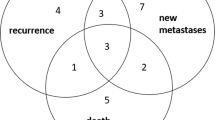Abstract
Colorectal cancer is one of the leading death causes in the world. Specificity and sensitivity of the present screening methods are unsuitable and their compliance is too low. Nowadays the most effective method is the colonoscopy, because it gives not only macroscopic diagnosis but therapeutic possibility as well, however the compliance of the patients is very low. Hence development of new diagnostic methods is needed. Altered expression of septin 9 was found in several tumor types including colorectal cancer. The aim of this study was to detect the methylation related mRNA and protein expression changes of septin 9 in colorectal adenoma-dysplasia-carcinoma sequence and to analyze its reversibility by demethylation treatment. Septin 9 protein expression showed significant difference between normal and colorectal cancer (CRC) samples (p < 0,001). According to biopsy microarray results, septin 9 mRNA expression decreased in the progression of colon neoplastic disease (p < 0,001). In laser microdissected epithelial cells, septin 9 significantly underexpressed in CRC compared to healthy controls (p < 0,001). The expression of septin9_v1 region was higher in the healthy samples, while septin9_v2, v4, v4*, v5 overexpression were detected in cancer epithelial cells compared to normal. The septin 9 mRNA and protein levels of HT29 cells increased after demethylation treatment. The increasing methylation of septin 9 gene during colorectal adenoma-dysplasia-carcinoma sequence progression is reflected in the decreasing mRNA and protein expression, especially in the epithelium. These changes can be reversed by demethylation agents converting this screening marker gene into therapeutic target.




Similar content being viewed by others
References
Boyle P, Ferlay J (2005) Cancer incidence and mortality in Europe, 2004. Ann Oncol 16:481–488
Jemal A, Murray T, Ward E et al (2005) Cancer statistics, 2005. CA Cancer J Clin 55:10–30
Ebert MP, Model F, Mooney S et al (2006) Aristaless-like homeobox-4 gene methylation is a potential marker for colorectal adenocarcinomas. Gastroenterology 131:1418–1430
Lofton-Day C, Model F, Devos T et al (2008) DNA methylation biomarkers for blood-based colorectal cancer screening. Clin Chem 54:414–423
Grützmann R, Molnar B, Pilarsky C et al (2008) Sensitive detection of colorectal cancer in peripheral blood by septin 9 DNA methylation assay. PLoS ONE 3:e3759
Devos T, Tetzner R, Model F et al (2009) Circulating methylated SEPT9 DNA in plasma is a biomarker for colorectal cancer. Clin Chem 55:1337–1346
Scott M, Hyland PL, McGregor G et al (2005) Multimodality expression profiling shows SEPT9 to be overexpressed in a wide range of human tumours. Oncogene 24:4588–4700
Galamb O, Györffy B, Sipos F (2008) Inflammation, adenoma and cancer: objective classification of colon biopsy specimens with gene expression signature. Dis Markers 25:1–16
Hall PA, Russell SE (2004) The pathobiology of the septin gene family. J Pathol 204:489–505
Russell SE, McIlhatton MA, Burrows JF (2000) Isolation and mapping of a human septin gene to a region on chromosome 17q, commonly deleted in sporadic epithelial ovarian tumors. Cancer Res 60:4729–4734
Kalikin LM, Sims HL, Petty EM (2000) Genomic and expression analyses of alternatively spliced transcripts of the MLL septin-like fusion gene (MSF) that map to a 17q25 region of loss in breast and ovarian tumors. Genomics 63:165–172
Burrows JF, Chanduloy S, McIlhatton MA et al (2003) Altered expression of the septin gene, SEPT9, in ovarian neoplasia. J Pathol 201:581–588
Montagna C, Lyu MS, Hunter K et al (2003) The Septin 9 (MSF) gene is amplified and overexpressed in mouse mammary gland adenocarcinomas and human breast cancer cell lines. Cancer Res 63:2179–2187
Tatsumi K, Taki T, Taniwaki M et al (2001) The CDCREL1 gene fused to MLL in de novo acute myeloid leukemia with t(11;22)(q23;q11.2) and its frequent expression in myeloid leukemia cell lines. Genes Chromosom Cancer 30:230–235
Kim HJ, Ki CS, Park Q et al (2003) MLL/SEPTIN6 chimeric transcript from invins(X;11)(q24;q23q13) in acute monocytic leukemia: report of a case and review of the literature. Genes Chromosom Cancer 38:8–12
Kojima K, Sakai I, Hasegawa A et al (2004) FLJ10849, a septin family gene, fuses MLL in a novel leukemia cell line CNLBC1 derived from chronic neutrophilic leukemia in transformation with t(4;11)(q21;q23). Leukemia 18:998–1005
Tanaka M, Tanaka T, Matsuzaki S et al (2003) Rapid and quantitative detection of human septin family Bradeion as a practical diagnostic method of colorectal and urologic cancers. Med Sci Monit 9:61–68
Kim DS, Hubbard SL, Peraud A et al (2004) Analysis of mammalian septin expression in human malignant brain tumors. Neoplasia 6:168–178
Model F, Osborn N, Ahlquist D et al (2007) Identification and validation of colorectal neoplasia-specific methylation markers for accurate classification of disease. Mol Cancer Res 5:153–163
Tóth K, Galamb O, Spisák S et al (2009) Free circulating DNA based colorectal cancer screening from peripheral blood: the possibility of the methylated septin 9 gene marker. Orv Hetil 150:969–977
Scott M, McCluggage WG, Hillan KJ et al (2006) Altered patterns of transcription of the septin 9 gene, SEPT9, in ovarian tumorigenesis. Int J Cancer 118:1325–1329
Montagna C, Lyu MS, Hunter K (2003) The Septin 9 (MSF) gene is amplified and overexpressed in mouse mammary gland adenocarcinomas and human breast cancer cell lines. Cancer Res 63:2179–2187
Gonzalez ME, Peterson EA, Privette LM (2007) High SEPT9_v1 expression in human breast cancer cells is associated with oncogenic phenotypes. Cancer Res 67:8554–8564
Liu ZJ, Wang G, Cai Y (2009) Androgen receptor CpG island methylation status in human leukemia cancer cells. Cancer Investig 27:156–162
Yap OW, Bhat G, Liu L et al (2009) Epigenetic modifications of the Estrogen receptor beta gene in epithelial ovarian cancer cells. Anticancer Res 29:139–144
Deng G, Kakar S, Okudiara K et al (2009) Unique methylation pattern of oncostatin m receptor gene in cancers of colorectum and other digestive organs. Clin Cancer Res 15:1519–1526
Author information
Authors and Affiliations
Corresponding author
Rights and permissions
About this article
Cite this article
Tóth, K., Galamb, O., Spisák, S. et al. The Influence of Methylated Septin 9 Gene on RNA and Protein Level in Colorectal Cancer. Pathol. Oncol. Res. 17, 503–509 (2011). https://doi.org/10.1007/s12253-010-9338-7
Received:
Accepted:
Published:
Issue Date:
DOI: https://doi.org/10.1007/s12253-010-9338-7




